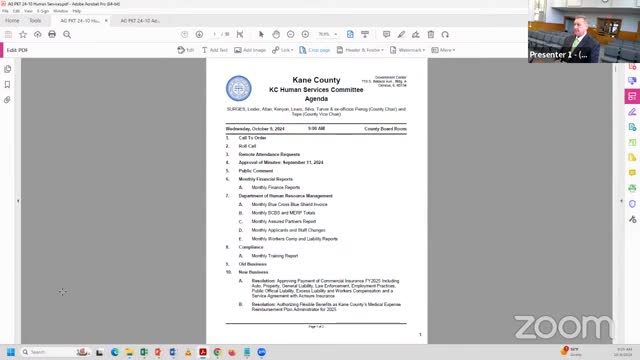Insurance expert warns of rising storm and earthquake risks
October 09, 2024 | Kane County, Illinois
This article was created by AI summarizing key points discussed. AI makes mistakes, so for full details and context, please refer to the video of the full meeting. Please report any errors so we can fix them. Report an error »

In a recent government meeting, officials discussed the pressing issue of rising insurance premiums linked to increasing natural disasters. A representative highlighted the importance of having adequate insurance coverage, including flood and earthquake protection, despite the challenges posed by certain locations being in flood zones.
The conversation shifted to the broader implications of climate change, with the representative noting a significant uptick in the frequency and severity of storms over the past decade. They referenced catastrophic events not only in the local area but also globally, including severe flooding in Bosnia and Germany, wildfires in California, and tornadoes across the Midwest.
The representative emphasized that the reinsurance market, which provides insurance for insurance companies, is heavily impacted by these disasters. As the costs of claims rise, the industry is forced to increase premiums to recover losses. They pointed out that the traditional metrics used to assess risk—based on historical storm frequency—are no longer applicable, as severe weather events are occurring much more frequently than previously recorded.
The discussion underscored the need for communities to reassess their preparedness for natural disasters and the role of insurance in mitigating financial risks. The representative expressed a willingness to facilitate access to safety engineering services to help residents better protect themselves against future storms.
As the meeting progressed, officials acknowledged the challenges faced by the insurance industry and the necessity for a collective approach to address the escalating costs and risks associated with climate-related events.
The conversation shifted to the broader implications of climate change, with the representative noting a significant uptick in the frequency and severity of storms over the past decade. They referenced catastrophic events not only in the local area but also globally, including severe flooding in Bosnia and Germany, wildfires in California, and tornadoes across the Midwest.
The representative emphasized that the reinsurance market, which provides insurance for insurance companies, is heavily impacted by these disasters. As the costs of claims rise, the industry is forced to increase premiums to recover losses. They pointed out that the traditional metrics used to assess risk—based on historical storm frequency—are no longer applicable, as severe weather events are occurring much more frequently than previously recorded.
The discussion underscored the need for communities to reassess their preparedness for natural disasters and the role of insurance in mitigating financial risks. The representative expressed a willingness to facilitate access to safety engineering services to help residents better protect themselves against future storms.
As the meeting progressed, officials acknowledged the challenges faced by the insurance industry and the necessity for a collective approach to address the escalating costs and risks associated with climate-related events.
View full meeting
This article is based on a recent meeting—watch the full video and explore the complete transcript for deeper insights into the discussion.
View full meeting
